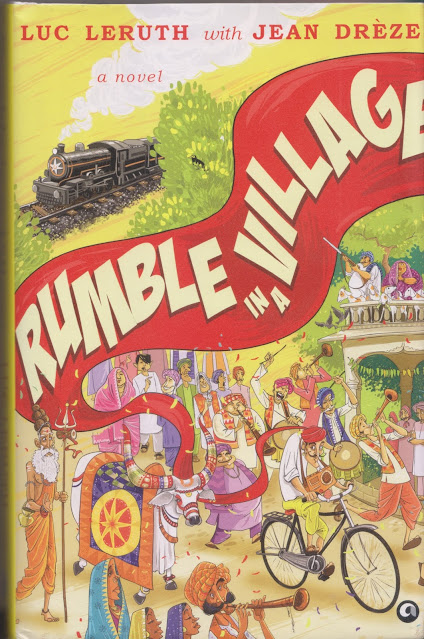Beyond the clichéd north Indian village
Rumble in a Village
Authors: Luc Leruth with Jean Dreze
Published by: Aleph
ISBN: 978-93-89836-12-7
Number of pages: 292
Year of Publishing: 2020
Price: 699/-
Cover Illustration: Mohit Suneja
This review was published at the Purple Pencil Project. Many thanks to the team there.
Fiction often allows subject specialists to explore ideas and topics in inventive ways, far removed from the restrictions that research papers ask for. Many talk about taking the fiction route but few end up taking it up and rare are those who manage it with a flair. Rumble in a Village, by Luc Leruth and Jean Dreze is exactly one such book. Set in rural North India, and borrowing heavily from Jean Dreze’s experiences as a development economist.
Throwing everything cliche about a sleepy old village out of the window, Rumble in a Village, is, as Nandana Sen has testified on the cover, “disturbing in its truth” and “infectious in its humour”.
The book begins with a phone call. A banker in Europe is asked to come to India as he has inherited a property. The banker, the protagonist, is "shocked into silence" but goes to figure out what it is all about.
His experiences in the village form 1 of the 2 tracks in the book. The book tells us how he learns and unlearns about life in rural north India. He also gets aware of his uncle having been murdered and attempts to understand what lay behind. The book is based during the early 1980’s and makes one wonder how much – if at all – has changed since then. On a few occasions, as I flipped pages, I stopped, closed my eyes and spent few minutes in silence. Some of the incidents described took me back to my days– couple of years – in a village in north India, sometime between the early 1980’s and today.
The other track comes in the form of ‘some notes’ Anil Singh’s father had written after his visit to the village, Palampur, where the property is located. These notes talk about the village and its people (including the ancestors of the people Anil singh interacts with) over a 70 year span. The notes are also "inspired by historical facts".
Both the tracks together take the story ahead and keep the reader hooked!
The book highlights social issues in a stark yet light-hearted tone. These lines where it talks about railways, during their initial days in the country, may give an idea. . .
“Train building was a costly exercise in lives and money. Later, as the English claimed they had donated the vast rail network to their colony, there were bitter smiles from those who had built it with their sweat and blood".
“ ‘Are the tracks removed behind the train as it moves forward, and carried to the front so that it can continue its journey?’, That question was also raised by several people who found it hard to believe that all the steel needed to cover India with tracks could actually exist".
The second trail is about the protagonist coming to Palanpur on death of his uncle and his experiences as he learns and unlearns about life in rural north India. In the process he also gets aware to his uncle having been murdered and attempts to understand what lay behind.
Somewhere during the middle though too many characters (both trails put together) make the going difficult. Also, as one moves towards the end the story-line tends to get predictable.
This book has its share of one liners which one may re-read and ponder on. Sample these:
“This has always surprised me: simpler things can actually be sexier than complicated ones”.
“In mysterious ways that have always baffled colonizers all over the world, the colonized could achieve results without using the more advanced techniques of their masters”.
Rumble in a Village makes its biases clear, in black and white, as the plot unfolds. This clarity helps the story move ahead and is relatable to the average Indian reader. The authors appear to agree with Neil Gaiman’s take on fiction, "a lie which states the truth". The elite have exploited rural north India at different levels, and continue to. If it was the Britishers and Zamindars in the days gone by today it includes the academicians. The research supervisor, one of the characters that make a brief appearance, is a character not very difficult to come across in today’s time. This is a person who thinks s/he knows it all – without investing time with people or at place concerned – is ok with trading new learning opportunities to maintain her/ his comfort levels and treats people as less than equals.
Exploitation brings us to Caste. The authors have the benefit of being culturally distant. This has enabled them to write about caste in an astute manner. ‘Caste inevitably runs through this novel’ as the preface states. The upper caste police officer openly violates the basic rights of the lower caste people, other people from upper caste too lose no opportunity to show that they are above the rest and so on. At one point the protagonist is told, "A Chamar does not have a rifle. It is a Thakur privilege. . . for a man of course".
Read the book to know more about life in a village in north India. Or, to know more about how to observe life around during one’s research and then share the experience with a wider audience. Or, simply read it for a good story. The preface too states, "best to read this story like the richly embroidered epics of yore".


Comments
Post a Comment